| Article ID | Journal | Published Year | Pages | File Type |
|---|---|---|---|---|
| 8645145 | Gene | 2018 | 13 Pages |
Abstract
Sperm malformation is one of the main reasons for male infertility, but the precise mechanisms of this process remain undiscovered. The major process of spermiogenesis is sperm head shaping. Cytoskeleton is a crucial unit in this process, as the acroplaxome and manchette are two kinds of momentous structures cooperated with various functional proteins to insure the formation of acrosome and nucleus. One is primarily formed by filamentous actin (F-actin) and responsible for transverse acrosome extension and concentration, another plays as the mainstay of nuclear deformation through circular arrangement of microtubules (MTs). We suspect that the acroplaxome alone cannot maintain such a spatial framework of the acrosome. Previous studies have also revealed that a nucleus without acrosome could not induce the formation of ectoplasmic specialization. In this review, we integrated most of the key proteins that have been proven to participate in the essential developmental steps of post-meiosis. We also propose that the ambient MTs of the acrosome might be emanated from the Golgi apparatus. They form a novel cytoskeleton termed acroframosome (AFS) to transport vesicles and proteins during acrosome biogenesis. The hypothesis of the acroframosome-acroplaxome-manchette (AAM) cytoskeletal system is likely to be the axis of head-to-tail spermiogenesis.
Keywords
AFSLINCIFTUBPLCXG-actinMTOCAAMTGNPRMIMTF-actinfilamentous actinubiquitin-proteasome pathwaySpermiogenesisintraflagellar transportMicrotubuleTrans-Golgi networkManchettelinker of nucleoskeleton and cytoskeletonmicrotubule organizing centerMapsfollicle-stimulating hormoneFSHmicrotubule-associated proteinsTransition proteinProtamineCytoskeleton
Related Topics
Life Sciences
Biochemistry, Genetics and Molecular Biology
Genetics
Authors
Ya-Lan Wei, Wan-Xi Yang,
